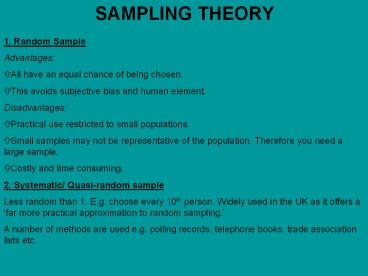SAMPLING THEORY - PowerPoint PPT Presentation
1 / 3
Title:
SAMPLING THEORY
Description:
Title: SAMPLING THEORY Author: Dean Lynes Last modified by: Dean Lynes Created Date: 9/11/2006 1:59:46 PM Document presentation format: On-screen Show – PowerPoint PPT presentation
Number of Views:89
Avg rating:3.0/5.0
Title: SAMPLING THEORY
1
SAMPLING THEORY
- 1. Random Sample
- Advantages
- All have an equal chance of being chosen.
- This avoids subjective bias and human element.
- Disadvantages
- Practical use restricted to small populations.
- Small samples may not be representative of the
population. Therefore you need a large sample. - Costly and time consuming.
- 2. Systematic/ Quasi-random sample
- Less random than 1. E.g. choose every 10th
person. Widely used in the UK as it offers a far
more practical approximation to random sampling. - A number of methods are used e.g. polling
records, telephone books, trade association lists
etc.
2
- 3. Stratified random-sampling
- This sample is divided up into segments or
strata, often preferred as it makes the sample
more representative of the whole group. - For example if a business wished know how class
affects demand for food. Put the population into
classes then take a random sample from these. - 4. Quota sampling
- Population is segmented and interviewers are
given targets/quotas. - Advantages
- Cheaper
- Faster
- Administrative efficiency
- Useful when population has definite segments.
- Disadvantages
- Sample is not randomly chosen.
- Selection bias.
3
- 5. Cluster sampling
- Put population into clusters (often via
geographic areas then take a random sample from
the cluster). - Advantages
- Useful if population is widely spread
- Cheap and fast.
- Disadvantages
- May miss sections of the population if only have
a few clusters. - 6. Multi-stage sampling
- Random systematic method
- Choose country at random
- City
- District
- Street
- Household
- This method is bad when it is widely dispersed
and is also very expensive - 7. Snowballing
- Highly specialised start with one individual or
group and use these to contact others. Only used
when sampling methods arent possible.































